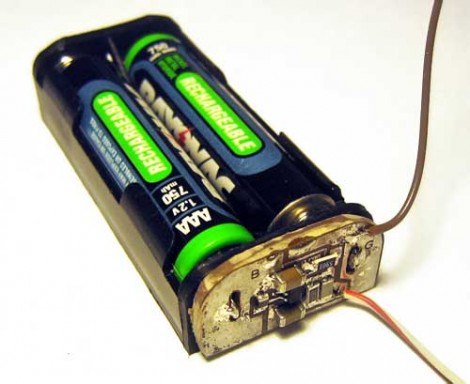
Here’s another circuit that can be used to squeeze the remaining potential from supposedly dead batteries. Just like the AASaver, we see this as a useful prototyping tool, providing juice for a breadboard even though it’s not reliable enough for long-term use (the batteries are just about through after all).
First off, the image above shows rechargeables instead of alkalines. We don’t recommend this as the circuit has no cutoff feature and the 0.7V input for the boost converter surely is below the recommended low-voltage limit for those cells. But that aside, we like the diminutive board which solders onto the end of a battery pack. It uses an SC120SKTRT which is a variable boost regulator capable of outputting 1.8-5V depending on resistor choices. You can leave the resistors off and it will default to 3.3V, set the output explicitly, or roll in some potentiometers and use your multimeter to tune the output.
This regulator costs more than the MCP1640 used in the AASaver, but it appears to use less passive components making for a smaller footprint. At a total of $3.50 plus the PCB (which will be a snap to etch at home) this is another great option to top off your next parts order.
[Thanks Uwe]















It doesn’t have to be limited to almost-all-used batteries, either. If you’ve got a project that needs 5V, you can use this with fresh batteries to get the voltage you need.
Those are nickel cells, not lithium. Discharging them to nothing will not cause anything bad to happen.
Nice project from a site featuring reptiles and nixie tubes. Good man!
Actually.. These are rechargeable batteries, and discharging them much below 1.1v (for Ni-Mh) is bad.
the standard discharge voltage of nicad and Nimh battery is .9 volts as long as the amp draw is low they can be droped to .5 volt with no ill effects. even lower voltages (.25volt per cell)can be used but they require more attention next time you charge them.
Nope. It’s never good for rechargables to drain them to zero.
Both NiCd and Ni-Mh cells can be discharged to zero volts without damage.
See Battery University:
http://batteryuniversity.com/learn/article/how_to_store_batteries
The problem is that most battery packs are built with multiple cells connected in series. And since no two cells are 100% identical, one cell in the string will hit zero before the others. Further discharge of the pack at this point causes something called “cell reversal”. By the time the -pack- reaches zero, one of the cells is inevitably negative in voltage. And that is what causes damage.
Lithium variants and Lead acid cells are definitely different in this aspect. They both have a non-zero voltage under which they are damaged.
Hmm, I like this one a lot. The board is super small and would be cheap from DorkbotPDX. You could easily mount this on the metal backplane of your breadboard with some velcro and plug the wires in wherever they need to go… or connect them to the banana jacks that would also be on your breadboard. I would like to see it done with the MCP1640 though.
A breadboard like this one:
http://images.frys.com/art/product/big_shots/4611868.big.jpg
I’ve done something like this with that holder and chip.
But instead of providing power for a breadboard, it has a 1W LED driven at 100mA(0.33W) mounted on the circuit board.
The thing will provide max output down to about 0.4v
Good emergency light.